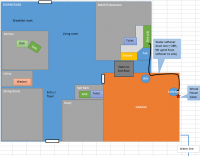So apparently this is abnormal - when my water softener regenerates, I can hear running/bubbling water sounds from the sinks plumbing in my master bedroom. Note I am not hearing the noise of the actual softener running, the machine is in the garage (about 28ft away, 5ft lower than the sink) and can only be heard in the garage. It is just the moving water sounds that we can hear in the master bath.
The house was built in 2005, and we purchased & moved in 2011. When we first moved in, this was happening (i.e. this is not a new problem)
The problem with the sounds is that they are enough to wake us up at night if the softener is set to regenerate at the traditional "middle of the night" time (1am, 2am, etc)
I want to replace the ineffective big box brand water softener with a quality setup using Fleck valve. I am seriously considering a twin tank setup using 9100SXT valve specifically so that we can set the regen time to the middle of the afternoon to avoid the plumbing noise waking us up at night.
Can anyone give any input regarding the water noise during regen, or my plan to buy a twin tank system because of it?
Thanks.
Oh, the house is 4 people, 3500sqft, 25gpg hardness, no iron, chlorine levels reported as 1.1 in city water report (San Antonio, TX)
Thanks
The house was built in 2005, and we purchased & moved in 2011. When we first moved in, this was happening (i.e. this is not a new problem)
The problem with the sounds is that they are enough to wake us up at night if the softener is set to regenerate at the traditional "middle of the night" time (1am, 2am, etc)
I want to replace the ineffective big box brand water softener with a quality setup using Fleck valve. I am seriously considering a twin tank setup using 9100SXT valve specifically so that we can set the regen time to the middle of the afternoon to avoid the plumbing noise waking us up at night.
Can anyone give any input regarding the water noise during regen, or my plan to buy a twin tank system because of it?
Thanks.
Oh, the house is 4 people, 3500sqft, 25gpg hardness, no iron, chlorine levels reported as 1.1 in city water report (San Antonio, TX)
Thanks
Last edited:

